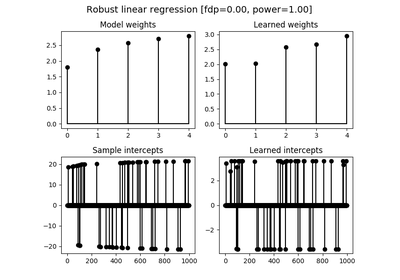tick.robust.RobustLinearRegression¶
-
class
tick.robust.RobustLinearRegression(C_sample_intercepts, C=1000.0, fdr=0.05, penalty='l2', fit_intercept=True, refit=False, solver='agd', warm_start=False, step=None, tol=1e-07, max_iter=200, verbose=True, print_every=10, record_every=10, elastic_net_ratio=0.95, slope_fdr=0.05)[source]¶ Robust linear regression learner. This is linear regression with sample intercepts (one for each sample). An ordered-L1 penalization is used on the individual intercepts, in order to obtain a sparse vector of individual intercepts, with a (theoretically) guaranteed False Discovery Rate control (see
fdrbelow).The features matrix should contain only continuous features, and columns should be normalized. Note that C_sample_intercepts is a sensitive parameter, that should be tuned in theory as n_samples / noise_level, where noise_level can be chosen as a robust estimation of the standard deviation, using for instance
tick.hawkes.inference.std_madandtick.hawkes.inference.std_iqron the array of labels.- Parameters
C_sample_intercepts :
floatLevel of penalization of the ProxSlope penalization used for detection of outliers. Ideally, this should be equal to n_samples / noise_level, where noise_level is an estimated noise level
C :
float, default=1e3Level of penalization of the model weights
fdr :
float, default=0.05Target false discovery rate for the detection of outliers, namely for the detection of non-zero entries in
sample_interceptspenalty : {‘none’, ‘l1’, ‘l2’, ‘elasticnet’, ‘slope’}, default=’l2’
The penalization to use. Default ‘l2’, namely ridge penalization.
fit_intercept :
bool, default=TrueIf
True, include an intercept in the model, namely a global interceptrefit : ‘bool’, default=False
Not implemented yet
solver : ‘gd’, ‘agd’
The name of the solver to use. For now, only gradient descent and accelerated gradient descent are available
warm_start :
bool, default=FalseIf true, learning will start from the last reached solution
step :
float, default=NoneInitial step size used for learning.
tol :
float, default=1e-7The tolerance of the solver (iterations stop when the stopping criterion is below it).
max_iter :
int, default=100Maximum number of iterations of the solver
verbose :
bool, default=TrueIf
True, we verbose things, otherwise the solver does not print anything (but records information in history anyway)print_every :
int, default=10Print history information when
n_iter(iteration number) is a multiple ofprint_everyrecord_every :
int, default=10Record history information when
n_iter(iteration number) is a multiple ofrecord_every- Attributes
weights :
numpy.array, shape=(n_features,)The learned weights of the model (not including the intercept)
sample_intercepts :
numpy.array, shape=(n_samples,)Sample intercepts. This should be a sparse vector, since a non-zero entry means that the sample is an outlier.
intercept :
floatorNoneThe intercept, if
fit_intercept=True, otherwiseNonecoeffs :
numpy.array, shape=(n_features + n_samples + 1,)The full array of coefficients of the model. Namely, this is simply the concatenation of
weights,sample_interceptsandintercept
-
__init__(C_sample_intercepts, C=1000.0, fdr=0.05, penalty='l2', fit_intercept=True, refit=False, solver='agd', warm_start=False, step=None, tol=1e-07, max_iter=200, verbose=True, print_every=10, record_every=10, elastic_net_ratio=0.95, slope_fdr=0.05)¶
-
fit(X: object, y: numpy.array)¶ Fit the model according to the given training data.
- Parameters
X :
np.ndarrayorscipy.sparse.csr_matrix,, shape=(n_samples, n_features)Training vector, where n_samples in the number of samples and n_features is the number of features.
y :
np.array, shape=(n_samples,)Target vector relative to X.
- Returns
self : LearnerGLM
The fitted instance of the model
-
get_params()¶ Get parameters for this estimator.
- Returns
params :
dictParameter names mapped to their values.
-
predict(X)¶ Not available. This model is helpful to estimate and detect outliers. It cannot, for now, predict the label based on non-observed features.
-
score(X)¶ Not available. This model is helpful to estimate and detect outliers. Score computation makes no sense in this setting.
-
set_params(**kwargs)¶ Set the parameters for this learner.
- Parameters
**kwargs : :
Named arguments to update in the learner
- Returns
output :
LearnerRobustGLMself with updated parameters
